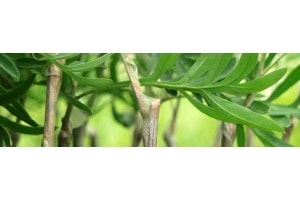
Kangaroo paws are such an iconic part of the Aussie landscape, and our home gardens.
They come in a wide range of colours : traditionally shades of red, orange, yellow; and a green-scarlet kind - but breeders are developing more colourways every year, including white and hot pink. There's also a rare black kind that we sell, which is a Macropidia rather than the usual Anigozanthos species.
Most kangaroo paws flower in spring, from late winter until early summer depending on the local climate and weather.
You can plant them almost all year round, apart from late summer.
Kangaroo paws can be quite fussy garden plants, even though they are natives.
Give them the right conditions and you'll have a better chance of them thriving in your garden.

Kangaroo Paws Love Drier Climates
The stems and flowers of kangaroo paws are covered in a fine velvety fuzz of hairs. In humid climates, this is like wearing a fuzzy mohair sweater that traps all the moisture - much better to wear a smooth nylon jacket the raindrops can roll right off! That's why they do well in dry climates, like those in the southern states and inland.
If you live in a humid climate, you can still grow kangaroo paws.
- Site them somewhere airy and open, with cross breezes.
- Give them plenty of space around each plant.
- Water into the soil, rather than over the plant
- If you notice black spots on the leaves, spray with fungicide
- Choose newer named varieties - breeders are developing kangaroo paws that are more resilient to different climates and conditions.
- For instance, Bush Coral and Bush Fury are very resilient and disease resistant.

Kangaroo Paws Love Free-Draining Soils
While they are growing and flowering, kangaroo paws thrive with regular watering. They can be adaptable as to soil type - so long as it is free-draining soil. That means water or rainfall moves quickly from the surface through the soil to the bedrock.
Improve your soil to help kangaroo paws grow
- Work in plenty of grit, horticultural sand, perlite, vermiculite or other inorganic matter to heavy soils to improve aeration and lighten the soil
- Grow your kangaroo paws on slopes and banks to aid with drainage
- Grow your kangaroo paws in a pot if your soil is heavy. We have several kangaroo paws that are smaller sized - perfect for pot growing.

Feeding Kangaroo Paws
Kangaroo paws often grow well in poor sandy light soils, rather than heavily fertilised loamy ones.They are usually sensitive to phosphorus and don't like over-rich soils.- Use native-specific or low-phosphorus fertiliser, not all-purpose plant food
- Add a handful of controlled release fertiliser for native plants to the soil when buds start to form, or after pruning to help the plant recover
- Test your soil's pH levels - kangaroo paws do better in neutral or slightly acidic soils
- Plant them with other phosphorus sensitive natives in your garden borders - like acacia, banksia, and hardenbergia - to make it easier

Pruning Kangaroo Paws
If you have one or two prized kangaroo paws
- Remove any damaged or dying leaves with secateurs or snips
- Cut back each clump of leaves and stems that have finished flowering
- You can chop these quite low, almost to the soil level
- Leave any leaf-clumps that didn't produce flowerstems
- For the taller (head-high) varieties, cut back spent flowerstems by about half. They'll often produce new buds lower down the stems
- You can also cut them earlier while the top flowers are fresh - kangaroo paws make excellent cut flowers for the home
If you have lots of kangaroo paws
- Remove any damaged or dying leaves - you can do this with shears, a lawnmower on high setting, or a whippersnipper!
- Cut back plants that have finished flowering
- You can chop them quite low, almost to the soil level



















